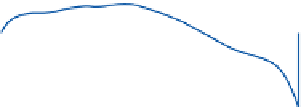Geoscience Reference
In-Depth Information
(A)
Dec-Feb (non-ENSO)
H
H
L
H
COLD
30°S
90°W
0°
90°E
180°
90°W
(B)
Dec-Feb 1982-1983 (ENSO)
H
L
WARM
30°S
90°W
0°
90°E
180°
90°W
(C)
Dec-Feb Sea surface temperatures (non-ENSO)
4
2
0
-2
-4
-6
90°W
0°
90°W
90°E
180°
(D)
Strong easterly wind (non-ENSO)
(e)
Weak easterly wind (ENSO)
cm
50
m
-50
-100
-150
-200
-250
-2
0
0
0
0
Figure 11.50
Schematic cross-sections of the Walker circulation along the equator based on
computations of Y. M. Tourre. A: Mean December to February regime (non-ENSO), La Niña; rising air and
heavy rains occur over the Amazon basin, central Africa and Indonesia-western Pacific. B: December to
February 1982-1983 ENSO pattern; the ascending Pacific branch is shifted east of the Date Line and
suppressed convection occurs elsewhere due to subsidence. C: Departure of sea surface temperature
from its equatorial zonal mean, corresponding to non-ENSO case (A). D: Strong trades cause sea level to
rise and the thermocline to deepen in the western Pacific for case (A). E: Winds relax, sea level rises in the
eastern Pacific as water mass moves back eastward and the thermocline deepens off South America
during ENSO events.
Source: Based on Wyrtki (1982). By permission World Meteorological Organization (1985).
sustained by the South Equatorial Current. This
westward-flowing current is wind-driven and is
compensated by a deeper surface slope. The
westward contraction of warm Pacific water into
the central and western tropical Pacific (
Figure
11.50C
) produces an area of instability and
convection fed by moisture in a convergence
zone under the dual influence of both the Inter-
tropical Convergence Zone and the South Pacific
Convergence Zone. The rising air over the western






































































































































